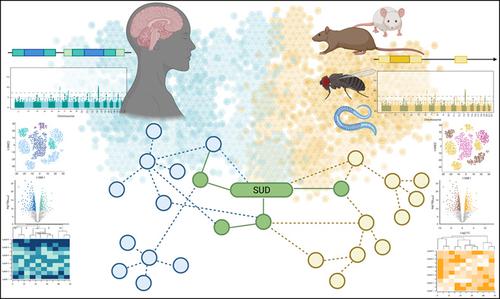当前位置:
X-MOL 学术
›
Genes Brain Behav.
›
论文详情
Our official English website, www.x-mol.net, welcomes your
feedback! (Note: you will need to create a separate account there.)
Integration of evidence across human and model organism studies: A meeting report
Genes, Brain and Behavior ( IF 2.4 ) Pub Date : 2021-04-23 , DOI: 10.1111/gbb.12738 Rohan H C Palmer 1 , Emma C Johnson 2 , Hyejung Won 3 , Renato Polimanti 4 , Manav Kapoor 5 , Apurva Chitre 6 , Molly A Bogue 7 , Chelsie E Benca-Bachman 1 , Clarissa C Parker 8 , Anurag Verma 9 , Timothy Reynolds 7 , Jason Ernst 10 , Michael Bray 2 , Soo Bin Kwon 10 , Dongbing Lai 11 , Bryan C Quach 12 , Nathan C Gaddis 12 , Laura Saba 13 , Hao Chen 14 , Michael Hawrylycz 15 , Shan Zhang 16 , Yuan Zhou 17 , Spencer Mahaffey 18 , Christian Fischer 19 , Sandra Sanchez-Roige 6 , Anita Bandrowski 20 , Qing Lu 17 , Li Shen 5 , Vivek Philip 7 , Joel Gelernter 4 , Laura J Bierut 2 , Dana B Hancock 12 , Howard J Edenberg 11, 21 , Eric O Johnson 12 , Eric J Nestler 5 , Peter B Barr 22 , Pjotr Prins 19 , Desmond J Smith 23 , Schahram Akbarian 24 , Thorgeir Thorgeirsson 25 , Dave Walton 7 , Erich Baker 26 , Daniel Jacobson 27, 28 , Abraham A Palmer 6, 29 , Michael Miles 30 , Elissa J Chesler 7 , Jake Emerson 7 , Arpana Agrawal 2 , Maryann Martone 20 , Robert W Williams 19
Genes, Brain and Behavior ( IF 2.4 ) Pub Date : 2021-04-23 , DOI: 10.1111/gbb.12738 Rohan H C Palmer 1 , Emma C Johnson 2 , Hyejung Won 3 , Renato Polimanti 4 , Manav Kapoor 5 , Apurva Chitre 6 , Molly A Bogue 7 , Chelsie E Benca-Bachman 1 , Clarissa C Parker 8 , Anurag Verma 9 , Timothy Reynolds 7 , Jason Ernst 10 , Michael Bray 2 , Soo Bin Kwon 10 , Dongbing Lai 11 , Bryan C Quach 12 , Nathan C Gaddis 12 , Laura Saba 13 , Hao Chen 14 , Michael Hawrylycz 15 , Shan Zhang 16 , Yuan Zhou 17 , Spencer Mahaffey 18 , Christian Fischer 19 , Sandra Sanchez-Roige 6 , Anita Bandrowski 20 , Qing Lu 17 , Li Shen 5 , Vivek Philip 7 , Joel Gelernter 4 , Laura J Bierut 2 , Dana B Hancock 12 , Howard J Edenberg 11, 21 , Eric O Johnson 12 , Eric J Nestler 5 , Peter B Barr 22 , Pjotr Prins 19 , Desmond J Smith 23 , Schahram Akbarian 24 , Thorgeir Thorgeirsson 25 , Dave Walton 7 , Erich Baker 26 , Daniel Jacobson 27, 28 , Abraham A Palmer 6, 29 , Michael Miles 30 , Elissa J Chesler 7 , Jake Emerson 7 , Arpana Agrawal 2 , Maryann Martone 20 , Robert W Williams 19
Affiliation

|
The National Institute on Drug Abuse and Joint Institute for Biological Sciences at the Oak Ridge National Laboratory hosted a meeting attended by a diverse group of scientists with expertise in substance use disorders (SUDs), computational biology, and FAIR (Findability, Accessibility, Interoperability, and Reusability) data sharing. The meeting's objective was to discuss and evaluate better strategies to integrate genetic, epigenetic, and 'omics data across human and model organisms to achieve deeper mechanistic insight into SUDs. Specific topics were to (a) evaluate the current state of substance use genetics and genomics research and fundamental gaps, (b) identify opportunities and challenges of integration and sharing across species and data types, (c) identify current tools and resources for integration of genetic, epigenetic, and phenotypic data, (d) discuss steps and impediment related to data integration, and (e) outline future steps to support more effective collaboration—particularly between animal model research communities and human genetics and clinical research teams. This review summarizes key facets of this catalytic discussion with a focus on new opportunities and gaps in resources and knowledge on SUDs.
中文翻译:

人类和模式生物研究证据的整合:会议报告
国家药物滥用研究所和橡树岭国家实验室生物科学研究所联合主办了一次会议,与会者包括在物质使用障碍 (SUD)、计算生物学和 FAIR(可查找性、可访问性、互操作性、和可重用性)数据共享。会议的目标是讨论和评估更好的策略,以整合人类和模型生物体的遗传、表观遗传和组学数据,以实现对 SUD 更深入的机制洞察。具体主题包括 (a) 评估物质使用遗传学和基因组学研究的现状以及基本差距,(b) 确定跨物种和数据类型整合和共享的机遇和挑战,(c) 确定当前用于整合物质使用遗传学和基因组学研究的工具和资源。遗传、表观遗传和表型数据,(d) 讨论与数据集成相关的步骤和障碍,(e) 概述未来支持更有效合作的步骤,特别是动物模型研究团体与人类遗传学和临床研究团队之间的合作。本综述总结了这一催化讨论的关键方面,重点关注 SUD 资源和知识方面的新机遇和差距。
更新日期:2021-04-23
中文翻译:

人类和模式生物研究证据的整合:会议报告
国家药物滥用研究所和橡树岭国家实验室生物科学研究所联合主办了一次会议,与会者包括在物质使用障碍 (SUD)、计算生物学和 FAIR(可查找性、可访问性、互操作性、和可重用性)数据共享。会议的目标是讨论和评估更好的策略,以整合人类和模型生物体的遗传、表观遗传和组学数据,以实现对 SUD 更深入的机制洞察。具体主题包括 (a) 评估物质使用遗传学和基因组学研究的现状以及基本差距,(b) 确定跨物种和数据类型整合和共享的机遇和挑战,(c) 确定当前用于整合物质使用遗传学和基因组学研究的工具和资源。遗传、表观遗传和表型数据,(d) 讨论与数据集成相关的步骤和障碍,(e) 概述未来支持更有效合作的步骤,特别是动物模型研究团体与人类遗传学和临床研究团队之间的合作。本综述总结了这一催化讨论的关键方面,重点关注 SUD 资源和知识方面的新机遇和差距。











































 京公网安备 11010802027423号
京公网安备 11010802027423号